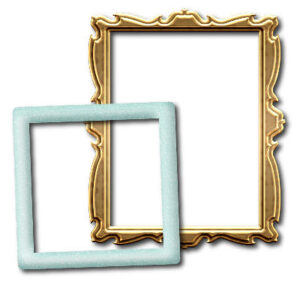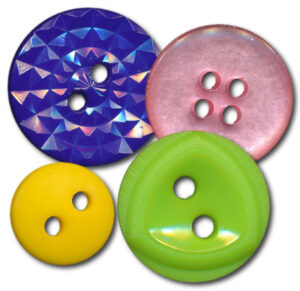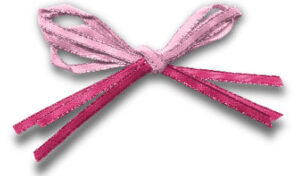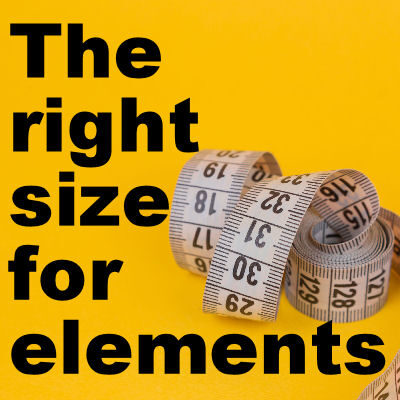When creating elements for your own projects, you will surely go by eye and create the elements at the size you need them at the time. However, if you want to create some kits and elements to share with others, they might need something that is different from what you did. Although you can easily resize in PaintShop Pro, it is a good idea to create elements within a certain range of sizes that will suit most projects.
Basic size
If you are creating elements for digital scrapbooking, the base size of a page will be 12x12 inches or 3600x3600 pixels. This assumes a standard resolution of 300 ppi. Although the resolution itself is not that important when working digitally, let's use that standard to help with the calculation. If you want to learn more about resolution, you can read this article.
Since papers will typically be 3600x3600 pixels, you will want to make sure your patterns will make sense. For example, if you have polkadots on a 30x30 pixels image, it will be tiny. If you make them on a 600x600 pixels canvas, it will be quite large, and possibly overpowering. Depending on the type and complexity of a repeated design, you can use a pattern that will range between 100 and 300 pixels to fill your full-size paper.
 Photo Elements
Photo Elements
Although digital scrapbooking is not limiting you to the traditional size of printed photos, like 3x5 and 4x6, you might still want to use that as a general guideline to create photo spots in templates. Furthermore, it will also give you some idea for frames. If you don't use the exact measurements, keep the proportions in mind. A ratio of 3:5 or 3:2 would be reasonable for most people.
Ribbons
Most kits will include some sort of ribbons. Although you might have enough ribbons with a full length of 3600 pixels, it is a good idea to make them longer. Making ribbons 4000 pixels will allow the user to place them at an angle, while still concealing the ends. As far as thickness, ribbons can range from 1/4" to about 1 inch for the thick ones. Most typical ribbons will be around 100-200 pixels.
 Fasteners
Fasteners
Many kits will include a variety of fasteners. If you create some, remember that they are typically going to simulate real elements. Although you can use any size to work in PaintShop Pro, you might as well plan ahead and know how big you want your elements. If you look at clothing, buttons would range between half an inch and an inch for large ones. So you can aim for something between 150-300 pixels. Staples, on the other hand, would be no longer than half an inch, or 150 pixels. Standard shape paperclips will be about an inch by a quarter-inch, so 300x75 pixels. Of course, if you have some fancier shapes, they could be wider.
 Bows
Bows
Since bows are made from ribbons, you need to be consistent with their size. If you use a half-inch ribbon to create a matching bow, don't resize it to the point where the two, side by side, won't be the same size. The full dimensions of the bow will depend on the type of bow, how many loops, if it has tails, etc. In the end, refer to the actual thickness of the ribbon used to tie the bow and just make sure that is a reasonable thickness. Larger bows can be around 2000x1000 pixels while small ones can be 800x500 pixels.
Ropes and strings
Just like ribbons, if you want ropes and strings in a straight line, you might want to make them longer than the full size of a paper. However, it is also likely that you will want to create them in different shapes. In that case, you can create a design as large as a full-size page, or as small as a little bow. The thickness of the element will depend on what you want. A rope for a nautical theme will be something thick, around 80-90 pixels. On the other hand, a fine string might be only 30 pixels thick. And of course, the length of a string can be anything you want!
Tags
Whether you use them to add a little design for purely decorative purposes, or you plan on adding a date or short detail, tags would be around one to three inches. Of course, the more information you will want to add to the tags, the larger they can be. And if you want to add a string to it, the overall image will be larger. On average, aim for tags (without the string) to be at least 800x800 pixels if they are round or square, and 500x800 pixels if they are rectangular.
Alpha
Although titles can be written with the Text tool, it can be fun to have ready-made letters. Since those would likely be used mostly as titles, they can be fairly large. If you have a short title, of one or two words, you can easily fit letters that are one to two inches wide. Proportionally, it means that they can be two to three inches tall (depending on the font used). In terms of pixels, it means that each letter can be about 500x700 pixels.
There are definitely other elements that could be included in a kit. Although there is no absolute value for each of those individual elements, consider their actual size in real life. With a resolution of 300 ppi in your PaintShop Pro, it means that you calculate the size in inches and multiply by 300. If you are using centimeters, the resolution would be 114, so you calculate the dimension in cm, and multiply by 114.















1 thought on “The right size for elements”
Thanks ! this is a very helpful blog for me.